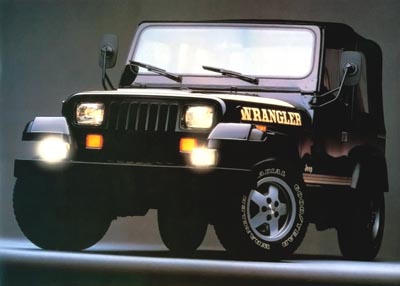Why the Wrangler YJ Replaced the CJ7
by LHM
(Texas)

1987 Jeep Wrangler YJ (file photo)
I came across this article by Daniel Strohl from Aug 15th, 2019 published by Hemmings.com titled "The Jeep YJ was necessary because people kept suing AMC over the CJ"
Here it is in its entirety:
Automakers regularly freshen their products for a variety of reasons, and they do it often. Honda, after all, is on the 10th generation of its Accord; Toyota on the 12th generation of the Corolla. On the other hand, Jeeps – and here we’re talking about the flagship convertible four-wheel-drive rigs – change as little as possible. The original civilian Jeep, in all its permutations, remained relatively the same for 40 years and would have likely continued unchanged for far longer had it not been litigated out of existence.
When American Motors, then under partial Renault ownership, decided to end production of the Jeep CJ-7, loyal Jeep fans saw it as a punch to the gut and news reports framed it as the end of an American institution. According to the Washington Post, “a proud chapter in U.S. automotive history ended” when the last CJ, “global symbol of hardy American know-how,” rolled off a Toledo assembly line in January 1986.
The CJ’s replacement, the rectangle-headlamp, bent-grille YJ Wrangler, offended CJ fans to an extent that few vehicles have before or since. They called it the “Wrongler.” They derided the headlamps so much that Jeep switched back to round headlamps with the YJ’s replacement and hasn’t yet dared to use any other headlamp design. And they’ve shunned it in the collector-car market since, sinking the YJ’s values to well below any round-headlamp Jeep.
It’s not as though AMC executives just blundered into the YJ’s rectangle-headlamp design, however. They needed that break in continuity from the CJ to stem a tide of rollover lawsuits that had been bleeding the already financially unstable company for years.
According to a UPI report from February 1981, AMC had paid out $9 million in settlements on rollover lawsuits related to the CJ over the prior eight years, but suddenly faced a tidal wave of rollover lawsuits after a December 1980 60 Minutes segment on an Insurance Institute for Highway Safety report that detailed the CJ-5’s tendency to roll over “in even moderate-speed driving maneuvers on the highway.”
At the time, AMC countered that the Jeep CJ hadn’t necessarily been designed for highway use. “To say they are designed differently from regular passenger cars and that, therefore, they handle differently, is to state the obvious,” the UPI quoted an AMC spokesperson. Indeed, Karl Probst designed the Bantam Reconnaissance Car as a military vehicle and Willys, which ended up with the rights
AMC’s defense notwithstanding, the 60 Minutes segment prompted more lawsuits. By the time of the UPI report just a couple months later, it had 17 rollover lawsuits pending. Dozens more were waiting in the wings (by the time Jeep ended CJ production, it had more than 100 pending rollover lawsuits), along with false advertising claims from the Federal Trade Commission related to the rollover risk, more studies, and countless newspaper headlines. According to Paul Ingrassia’s “Engines of Change: A History of the American Dream in Fifteen Cars,” the liabilities from the rollover lawsuits added up to $2 billion.
One thing the company didn’t face, however, was any sort of oversight from the Reagan-era National Highway Traffic Safety Association, which refused to rule on petitions asking the agency to regulate sport-utility vehicle design. It merely had Jeep put stickers on CJs noting that the vehicles “will perform differently than conventional cars on pavement.”
Which is why, when it came time to make a change to the CJ, AMC focused on image more than substance. While the YJ did get wider axles and improvements to the steering system, both borrowed from the XJ Cherokee, along with an anti-roll bar and softer springs that lowered the vehicle by half an inch, the YJ still retained the CJ’s 93.4-inch wheelbase, basic ladder-frame chassis, four-wheel-leaf-spring suspension, carbureted six-cylinder engine, and even the basic body tub.
Regardless, the company marketed the YJ as an entirely new replacement for the CJ, focusing on the Wrangler name and the new appearance. “A totally new vehicle, not a freshened CJ,” AMC spokesman Jerry Sloan told the Washington Post. Not until the appearance of the TJ Wrangler a decade later did Jeep market an entirely re-engineered replacement.
That marketing approach appeared to work, judging from the still-simmering ire over the YJ among Jeep loyalists today. A conspiratorially minded observer might even begin to wonder whether AMC/Renault executives even welcomed the headlamp-shape controversy, if only because it bolstered the message that the CJ and the YJ were two radically different vehicles.
AMC/Renault didn’t have all that long to see whether the YJ’s introduction helped lighten the load on its legal department: The company announced the YJ in May 1986 as a 1987 model, less than a year before Renault sold AMC to Chrysler.
Link to original article:
The Jeep YJ was necessary because people kept suing AMC over the CJ
Comments for Why the Wrangler YJ Replaced the CJ7
|
||
|
||
|
||
|
Show Off Your Jeep on this Website for Free.. All Jeeps Were Not Created Equal! This easy to read ebook compares them all.  Winches Made for Your Jeep. Now winches are better made and cheaper to buy than ever!  Jeep Exhaust Manifolds. They crack and leak. Replace yours at the best price possible.  Jeep Bumpers and Tire Carriers. Replace those weak original bumpers and spare tire carrier. Your Jeep will be more functional and look cool too!  Jeep Rock Rails/Sliders. Protect your Jeep's vulnerable Rocker Panels...and look awesome at the same time!  Larry Morton, owner 4-The-Love-of-Jeeps.com They Give So We Can Be Free! |










